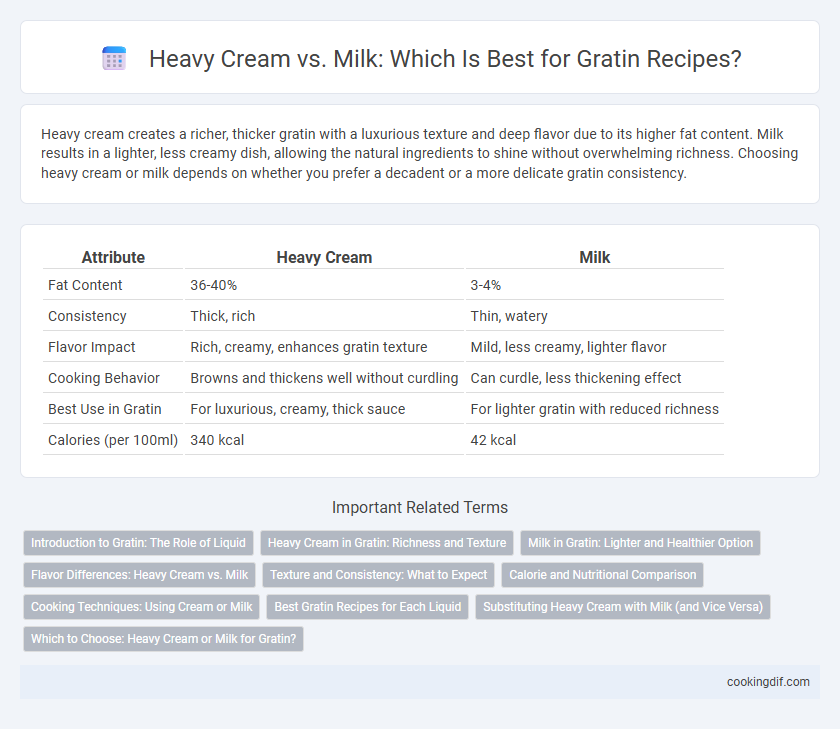Heavy cream creates a richer, thicker gratin with a luxurious texture and deep flavor due to its higher fat content. Milk results in a lighter, less creamy dish, allowing the natural ingredients to shine without overwhelming richness. Choosing heavy cream or milk depends on whether you prefer a decadent or a more delicate gratin consistency.
Table of Comparison
| Attribute | Heavy Cream | Milk |
|---|---|---|
| Fat Content | 36-40% | 3-4% |
| Consistency | Thick, rich | Thin, watery |
| Flavor Impact | Rich, creamy, enhances gratin texture | Mild, less creamy, lighter flavor |
| Cooking Behavior | Browns and thickens well without curdling | Can curdle, less thickening effect |
| Best Use in Gratin | For luxurious, creamy, thick sauce | For lighter gratin with reduced richness |
| Calories (per 100ml) | 340 kcal | 42 kcal |
Introduction to Gratin: The Role of Liquid
Heavy cream provides a rich, velvety texture essential for achieving the classic golden crust and creamy interior in a gratin, contributing to its indulgent flavor profile. Milk offers a lighter alternative, resulting in a less dense sauce that allows other ingredients to shine but may lack the luxurious mouthfeel of cream. Choosing between heavy cream and milk directly impacts the gratin's consistency, richness, and overall taste experience.
Heavy Cream in Gratin: Richness and Texture
Heavy cream in gratin provides a rich, velvety texture that enhances the dish's overall creaminess and depth of flavor. Its high fat content allows for a luscious, smooth sauce that clings well to ingredients, creating a luxurious mouthfeel. Unlike milk, heavy cream prevents the gratin from becoming watery, ensuring a perfectly thickened and indulgent finish.
Milk in Gratin: Lighter and Healthier Option
Milk in gratin offers a lighter texture and lower calorie count compared to heavy cream, making it a healthier choice for those mindful of fat intake. It blends smoothly with cheese and vegetables, maintaining creaminess while reducing richness. Using milk also allows the natural flavors of the ingredients to shine without overwhelming heaviness.
Flavor Differences: Heavy Cream vs. Milk
Heavy cream provides a rich, velvety texture and a pronounced buttery flavor that enhances the overall indulgence of gratin dishes, creating a creamy mouthfeel unmatched by milk. Milk, with its lighter consistency and milder taste, produces a less decadent gratin, allowing the natural flavors of cheese and vegetables to stand out more subtly. Choosing heavy cream intensifies the dish's richness, while milk offers a delicate balance and fewer calories, influencing both flavor depth and texture.
Texture and Consistency: What to Expect
Heavy cream in gratin creates a rich, velvety texture with a thicker, more luscious consistency, enhancing the dish's overall creaminess. Milk yields a lighter texture with a thinner consistency, resulting in a less indulgent but more delicate gratin. Choosing heavy cream intensifies the mouthfeel and provides a more stable sauce, while milk offers a subtler, smoother finish.
Calorie and Nutritional Comparison
Heavy cream contains approximately 50 calories per tablespoon and is rich in fat, providing about 5 grams of fat with minimal protein and carbohydrates, whereas milk offers roughly 9 calories per tablespoon with lower fat content but more protein and calcium. Using heavy cream in gratin yields a richer, creamier texture due to its high fat content, enhancing flavor but significantly increasing calorie and saturated fat intake compared to milk. Milk, especially whole or 2%, provides a lighter option with essential nutrients like vitamin D and calcium, making it preferable for those seeking lower calorie dishes while maintaining nutritional value.
Cooking Techniques: Using Cream or Milk
Using heavy cream in gratin recipes results in a richer, silkier texture due to its high fat content, which promotes a luscious, golden crust during baking. Milk offers a lighter alternative, producing a less dense sauce that still hydrates the ingredients but with a milder flavor and thinner consistency. The choice between cream and milk directly affects the gratin's creaminess, browning, and overall mouthfeel, making heavy cream ideal for indulgent dishes and milk suitable for lighter preparations.
Best Gratin Recipes for Each Liquid
Heavy cream creates a rich and velvety texture in gratins, perfect for indulgent dishes like classic Potato Gratin Dauphinois or creamy Cauliflower Gratin. Milk offers a lighter alternative, ideal for healthier options such as vegetable gratins or baked mac and cheese, providing moisture without overwhelming fat content. Choosing heavy cream or milk ultimately balances richness and healthiness, tailoring gratin recipes to desired flavor intensities and dietary preferences.
Substituting Heavy Cream with Milk (and Vice Versa)
Heavy cream provides a rich, thick texture essential for a properly creamy gratin, while milk offers a lighter, more fluid consistency that can make the dish less indulgent but lower in calories. When substituting heavy cream with milk, adding a tablespoon of butter per cup can help replicate the fat content and creaminess, ensuring the gratin retains its luxurious mouthfeel. Conversely, replacing milk with heavy cream increases richness and depth but may require reducing other fats in the recipe to prevent an overly greasy result.
Which to Choose: Heavy Cream or Milk for Gratin?
Heavy cream delivers a rich, velvety texture and intense flavor ideal for gratins, ensuring a creamy, golden-browned crust. Milk creates a lighter, less fatty dish but may result in a thinner sauce and reduced richness. Selecting heavy cream enhances indulgence, while milk suits those seeking a lighter, lower-calorie gratin.
Heavy cream vs Milk for liquid Infographic

 cookingdif.com
cookingdif.com